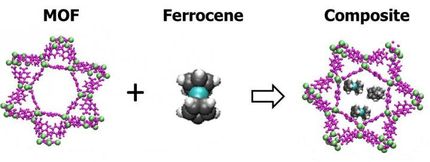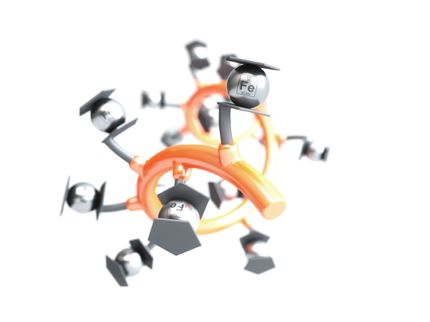Breakthrough: Chemists produce molecule for the first time that has been predicted for 20 years
"It's incredibly exciting and thrilling when you realize what you're holding in your hands!"
Advertisement
metallocenes, molecules consisting of two flat rings of carbon atoms and a metal atom in between, are also known as sandwich complexes or sandwich molecules due to their structure. In 2005, a sandwich molecule containing two different metal atoms was theoretically predicted for the first time. Chemist Inga Bischoff has now succeeded in producing such a molecule for the first time in the world. Her work has been published in the journal Nature Chemistry.
The first and best-known metallocene is "ferrocene", which contains an iron atom. Nowadays, it is impossible to imagine many areas of chemistry without such sandwich complexes. They can be found in many textbooks on inorganic chemistry, and chemistry students learn about them as early as their bachelor's degree. Sandwich molecules are used, for example, in materials science to synthesize special metal-containing plastics and in catalysis processes in the chemical industry.
Nobody knows exactly how many sandwich molecules there are today, but there are certainly thousands. What they almost all have in common: A single metal atom between the two flat rings of carbon atoms. That was the state of knowledge until 2004, when the discovery of a research group at the University of Seville caused a sensation. The scientists from Spain had succeeded in synthesizing a sandwich molecule with two metal atoms instead of just one. For a long time, this so-called "dimetallocene", which has two zinc atoms, remained the only example of its kind until a working group from the UK succeeded in synthesizing a very similar molecule with two beryllium atoms in 2023. Now Inga Bischoff from the working group led by Dr. André Schäfer has achieved a special feat: The chemist has produced a dimetallocene with two different metal atoms in the laboratory for the first time in the world.
Shortly after the discovery of the first dimetallocene in 2004, predictions were made that such sandwich molecules do not necessarily have to have two identical metal atoms, but that the complex should also be stable with two different metal atoms. These predictions were based on quantum chemical calculations and modeling with powerful computers. However, all attempts to create such a molecule in the laboratory were unsuccessful until Inga Bischoff's current breakthrough.
"It's incredibly exciting and thrilling when you realize what you're holding in your hands! To the naked eye, it just looks like a white powder. But I can still remember exactly how we first saw the experimentally determined molecular structure on the computer and knew that it was a sandwich molecule with two different metal atoms," says Dr. André Schäfer.
"The question of what exactly the rings of carbon atoms should look like plays just as big a role as the question of which metal atoms to combine and incorporate. Their electronic structure has to match," explains Inga Bischoff. "We incorporated the two metals lithium and aluminum in our 'heterobimetallic dimetallocene'. There were calculations that predicted that they would fit together well in such a molecule because their electronic structure is similar in some ways to that of two zinc atoms, which we already knew could form a stable dimetallocene molecule."
What sounds simple and straightforward, however, was the work of many months. The molecule is also so reactive that it can only be produced, stored and studied in a pure nitrogen or argon atmosphere. If it comes into contact with normal air, it decomposes. A whole team of scientists from Saarland University was ultimately involved in investigating the properties of this new molecule. They have now published their discovery in the journal Nature Chemistry.
"Our heterobimetallic dimetallocene represents a completely new class of sandwich molecules, so to speak," explains Dr. André Schäfer. "Perhaps the molecule will make it into a textbook one day. But first we have to research it further. We currently understand its structure quite well, but we still know very little about its reactivity. In the future, it might also be possible to synthesize other such dimetallocene molecules with other metal atoms if we find other suitable combinations of metals."
The enormous importance of this class of molecules can also be seen from the fact that the German chemist Ernst Otto Fischer and his British colleague Geoffrey Wilkinson were awarded the Nobel Prize in Chemistry in 1973 for "pioneering work, carried out independently of each other, on the chemistry of organometallic sandwich compounds".
Note: This article has been translated using a computer system without human intervention. LUMITOS offers these automatic translations to present a wider range of current news. Since this article has been translated with automatic translation, it is possible that it contains errors in vocabulary, syntax or grammar. The original article in German can be found here.
































































